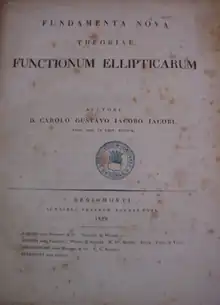 First edition | |
| Author | Carl Gustav Jacob Jacobi |
|---|---|
| Language | Latin |
| Subject | Jacobi elliptic functions |
| Genre | Non-fiction |
Publication date | 1829 |
| Media type | |
Fundamenta nova theoriae functionum ellipticarum[1] (from Latin: New Foundations of the Theory of Elliptic Functions) is a treatise on elliptic functions by German mathematician Carl Gustav Jacob Jacobi.[2] The book was first published in 1829, and has been reprinted in volume 1 of his collected works and on several later occasions. The book introduces Jacobi elliptic functions and the Jacobi triple product identity.
One of the most exciting moments of my life was when, after computing several of these series, I went down to our mathematical library and found some of them in Jacobi's "Fundamenta nova theoriae..."[3], with the same coefficients down to the last decimal digit!
Conway (1980, p.171) describing the discovery of monstrous moonshine.
References
- Citations
- ↑ Fundamenta nova theoriae functionum ellipticarum. By Carl Gustav Jacob Jacobi. Sumtibus fratrum, 1829.
- ↑ Given in Latin style as Carolo Gustavo Iacobo Iacobi in the book
- General
- Conway, John Horton (1980), "Monsters and moonshine", The Mathematical Intelligencer, 2 (4): 165–171, doi:10.1007/BF03028594, ISSN 0343-6993, MR 0600222, S2CID 121787388
- Cooke, Roger (2005), "Chapter 31 C. F. G. Jacobi, book on elliptic functions", in Grattan-Guinness, Ivor (ed.), Landmark writings in western mathematics 1640–1940, Elsevier B. V., Amsterdam, pp. 412–430, ISBN 978-0-444-50871-3, MR 2169816
- Jacobi, C. G. J. (1829), Fundamenta nova theoriae functionum ellipticarum (in Latin), Königsberg: Borntraeger, ISBN 978-1-108-05200-9, Reprinted by Cambridge University Press 2012
- Jacobi, C. G. J. (1969) [1881], Gesammelte Werke, Herausgegeben auf Veranlassung der Königlich Preussischen Akademie der Wissenschaften, vol. I–VIII (2nd ed.), New York: Chelsea Publishing Co., MR 0260557, archived from the original on 2013-05-13, retrieved 2012-10-14